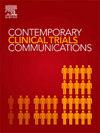为嵌入式实用临床试验招募临床研究机构的新方法:AIM-back 试验的启示
IF 1.4
Q4 MEDICINE, RESEARCH & EXPERIMENTAL
引用次数: 0
摘要
嵌入式实用临床试验(epct)评估现实世界环境中的干预措施。为epct招募临床地点的最佳实践尚不清楚,特别是对于研究团队不知道或不熟悉临床研究的地点。我们描述了AIM-Back的部位招募过程,这是退伍军人健康管理局(VA)治疗腰痛的两种非药物途径的ePCT。方法在AIM-Back试验的计划阶段,我们的目标是招募18-20个站点。符合条件的站点需要供应商能力、管理支持和地理隔离以避免污染。我们的三步方法包括:(1)通过现有的VA联系人,VA临床医生的数据库,以及在活动和列表服务器上的推广外展来识别(VA人员);(2)通过强调参与利益的量身定制的沟通引导参与;(3)与管理人员和临床医生的虚拟会议。结果我们在53个VA医疗保健系统中确定了184条线索。来自40个系统的领导对外联活动作出了回应,并与23个系统进行了招聘会议,涉及初级保健、物理治疗、研究人员和领导。我们实现了招聘目标,从19个网站获得了参与协议,从外联到参与协议的中间时间为3.7个月。不参与的常见原因包括基础设施和资源限制,对新的临床项目的抵制,以及竞争性项目。结论aim - back的招募突出了ePCT地点招募的复杂性,以参与新的临床研究地点。我们创新的三步招募方法为类似设计的试验提供了一个范例。未来的epct应考虑全面的招聘策略,以确保临床医生的购买,研究的可行性,并扩大现有的网络,以完成epct。本文章由计算机程序翻译,如有差异,请以英文原文为准。
Novel approaches to recruiting clinical sites for embedded pragmatic clinical trials: Insights from the AIM-back trial
Background
Embedded pragmatic clinical trials (ePCTs) assess interventions in real-world settings. Best practices for recruiting clinical sites for ePCTs are unknown, especially for sites that aren't known to the study team or familiar with clinical research. We describe the site recruitment process for AIM-Back, an ePCT of two nonpharmacologic pathways for low back pain within the Veterans Health Administration (VA).
Methods
During the planning phase of the AIM-Back trial, we aimed to recruit 18–20 sites. Eligible sites required provider capacity, administrative support, and geographic separation to avoid contamination. Our three-step approach involved: (1) lead (VA personnel) identification through existing VA contacts, data repositories of VA clinicians, and promotional outreach at events and listservs; (2) lead engagement via tailored communications emphasizing participation benefits; and (3) virtual meetings with administrators and clinicians.
Results
We identified 184 leads across 53 VA healthcare systems. Leads from 40 systems responded to outreach, and recruitment meetings were conducted with 23 systems involving primary care, physical therapy, research staff, and leadership. We met our recruitment goal, securing participation agreements from 19 sites, with a median timeline from outreach to participation agreement of 3.7 months. Common reasons for non-participation included infrastructure and resource constraints, resistance to new clinical programs, and competing programs.
Conclusion
AIM-Back's recruitment highlights ePCT site recruitment complexities for trials engaging new clinical research sites. Our innovative three-step recruitment approach provides an example for similarly designed trials. Future ePCTs should consider comprehensive recruitment strategies to ensure clinician buy-in, study feasibility, and broaden existing networks for completing ePCTs.
求助全文
通过发布文献求助,成功后即可免费获取论文全文。
去求助
来源期刊

Contemporary Clinical Trials Communications
Pharmacology, Toxicology and Pharmaceutics-Pharmacology
CiteScore
2.70
自引率
6.70%
发文量
146
审稿时长
20 weeks
期刊介绍:
Contemporary Clinical Trials Communications is an international peer reviewed open access journal that publishes articles pertaining to all aspects of clinical trials, including, but not limited to, design, conduct, analysis, regulation and ethics. Manuscripts submitted should appeal to a readership drawn from a wide range of disciplines including medicine, life science, pharmaceutical science, biostatistics, epidemiology, computer science, management science, behavioral science, and bioethics. Contemporary Clinical Trials Communications is unique in that it is outside the confines of disease specifications, and it strives to increase the transparency of medical research and reduce publication bias by publishing scientifically valid original research findings irrespective of their perceived importance, significance or impact. Both randomized and non-randomized trials are within the scope of the Journal. Some common topics include trial design rationale and methods, operational methodologies and challenges, and positive and negative trial results. In addition to original research, the Journal also welcomes other types of communications including, but are not limited to, methodology reviews, perspectives and discussions. Through timely dissemination of advances in clinical trials, the goal of Contemporary Clinical Trials Communications is to serve as a platform to enhance the communication and collaboration within the global clinical trials community that ultimately advances this field of research for the benefit of patients.
 求助内容:
求助内容: 应助结果提醒方式:
应助结果提醒方式:


